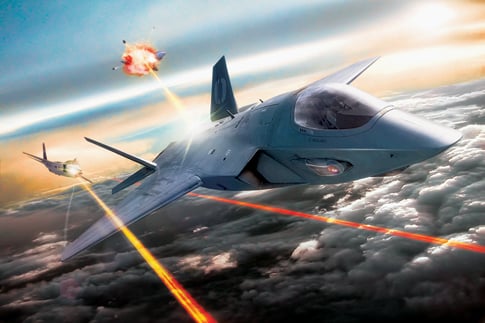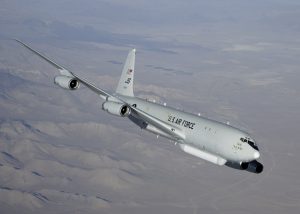By SYDNEY J. FREEDBERG JR.
Air Force artwork of a future dogfight with lasers.
 ARLINGTON: The Air Force’s new thinktank will study four different futures, only one of which is the official (and controversial) 386-squadron plan, Maj. Gen. Michael Fantini said. But first, said the director of the Air Force Warfighting Integration Capability, he needs to get enough people at AFWIC to do the work.
ARLINGTON: The Air Force’s new thinktank will study four different futures, only one of which is the official (and controversial) 386-squadron plan, Maj. Gen. Michael Fantini said. But first, said the director of the Air Force Warfighting Integration Capability, he needs to get enough people at AFWIC to do the work.
Air Force Sec. Heather Wilson and Chief of Staff David Goldfein created AFWIC last year under Maj. Gen. Clinton Crozier, whom Fantini recently replaced. The mission: to “design” the long-term future of the entire Air Force. That requires taking a multi-domain perspective that encompasses the service’s air, space, and cyberspace operations in a unified whole, then links them to the Army, Navy, and Marines — and ultimately to the allies, starting with “Five Eyes” partners like Britain and Australia, he said.
AWFIC is supposed to think both longer-term than Pentagon-based budgeteers and programmers, who stick to the five-year Program Objective Memorandum (POM) cycle. And it’s supposed to be bigger-picture than futurists at the Air Force’s 12 major commands — who focus on a particular portfolio like strategic bombing, tactical airpower, or air transport.
Hence Fantini’s four sweeping scenarios:
The “baseline” future is the 386-squadron force that Sec. Wilson proposed in September and will elaborate in a report to Congress required by Section 1064 of the National Defense Authorization Act. “That’s for today(:) We’re about 25 percent too small for what the nation has asked us to do,” Fantini told the Air Force Association yesterday. But he implied that figure isn’t final: “If you put a gun to my head today and say, how many squadrons do you need today, I’m going to say 386.” That number may change as the Air Force evolves, he said, and even if the overall figure stays at 386, the mix of squadrons will probably need to change.
The “evolutionary” future looks for new tactics, techniques, and technologies to make better use of what the Air Force already has in a future war. “Evolutionary is like using the force structure we have and figuring out how to use it more effectively,” Fantini told reporters after his AFA talk.
The “revolutionary” future includes more radical options to wage warfare from a distance (“stand-off”), such as large-scale use of remotely directed drones instead of manned aircraft with a human in the cockpit. Imagine, Fantini said, “I take virtual reality goggles and put them on, I’m fighting from a desk in (DC), and I’m controlling multiple penetrating capabilities in the western Pacific.”
The “disruptive” future is even more far-out, studying extreme possibilities like doing away with manned aircraft altogether in favor of big bets on drones, hypersonic missiles, or laser weapons.
“I guarantee that, probably, any one individual alternative is wrong,” Fantini said, “but inside each of these alternatives there’re pieces and parts that we’re going to be pull out that eventually are going to be some kind of hybrid, I bet you.”
“That’s Fantini’s intuition,” he caveated, not declared Air Force policy.
Nibbling At The Elephant
“Our job is to integrate across the enterprise… a pretty tall task,” Fantini said. “(So) we’re going to eat the elephant one bite at a time…. We’re going to be pragmatic about we take on” as the AFWIC staff grows. Staying focused is important: In rough terms, he said, “we shouldn’t have 100 activities, we should probably have 30.”
“We’re not going to be able to do it all in AFWIC,” Fantini emphasized. So to avoid reinventing expensive wheels, AFWIC will take advantage of existing resources across the Air Force, the Defense Department, and beyond. To give a less than exhaustive list:
the annual Futures Game in late February will help wargame options;
the Strategic Development Planning & Experimentation Office (SDPE) at the Air Force Research Laboratory will help pick promising technologies and push them into funded programs, along with the Air Force acquisition community under assistant secretary Will Roper;
the Pentagon’s Office of Cost Assessment and Program Evaluation (CAPE) will help project costs;
the Air Force staff’s studies, analyses, & assessments section (aka A9), Energy Department national laboratories like Sandia, academic research institutes like Johns Hopkins, and thinktanks like MITRE will assist with in-depth analysis;
the 12 major commands will provide expertise in their respective specialties. In fact, much of AFWIC’s personnel allocation is being carved out of the MAJCOMs’ own future-planning cells, with 40 billets coming from Air Combat Command alone.
To pull all this together, AFWIC will create a dozen “Cross Functional Teams.” (The name’s the same as the Army’s modernization CFTs, he said, and the philosophy is similar, but the specific role and structure are different). For each CFT, “the core team will be 10 to 12-ish,” he said, but they’ll pull expertise as needed from across the Air Force.
E-8C JSTARS Joint Surveillance Target Attack Radar System
 The overall list of 12 Cross Functional Teams “looks a lot like (the Air Force’s official) core functions,” Fantini said. He’s already stood up three, for Precision Navigation & Timing (i.e. how to live without GPS); networking; and command, control, communications, & computers (C4). An early focus for AFWIC — partnering “aggressively” with Air Force acquisition — will be the Airborne Battle Management System (ABMS), meant to replace the JSTARS radar plane with a network of drones, satellites, and other sensors that are harder to shoot down.
The overall list of 12 Cross Functional Teams “looks a lot like (the Air Force’s official) core functions,” Fantini said. He’s already stood up three, for Precision Navigation & Timing (i.e. how to live without GPS); networking; and command, control, communications, & computers (C4). An early focus for AFWIC — partnering “aggressively” with Air Force acquisition — will be the Airborne Battle Management System (ABMS), meant to replace the JSTARS radar plane with a network of drones, satellites, and other sensors that are harder to shoot down.
Fantini can’t build out all the teams, however, until AFWIC is fully manned. As of October, it had about 70 people, and Fantini’s now building it up to a target of 261, which will be a mix of military and civilians. He doesn’t expect all of them to arrive until the summer, when Permanent Change of Station (PCS) moves from one assignment to another traditionally take place.
When will AFWIC have the critical mass of people to make a visible impact on the Air Force? “AFWIC was told to inform and try to shape the ’20 POM,” Fantini told reporters, but that 2020-2024 budget plan is due out in February and was already largely locked down. “But the ’21 POM,” he said, it’s “game on.”
No comments:
Post a Comment